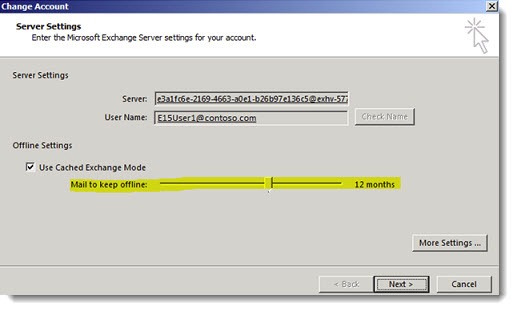
If you have a large Office 365 mailbox, Outlook 2010 may be slowing down even if your computer is otherwise running at full speed. A new feature in Outlook 2013 – the “sync slider” – might improve performance significantly, and as a nice bonus you would also get the benefit of the other improvements in Outlook and the other Office programs.
How big is your mailbox?
In Outlook 2010 or 2013, click on File. Your mailbox size is shown by the Cleanup Tools button. You have to subtract – it displays the free space and the total size available, so the difference is the size of your mailbox.

Office 365 business mailboxes are given 50Gb of space, so you can tell from the image above that my mailbox is 5Gb. That’s everything in all folders – mail, contacts, calendar, tasks. A few years ago that would have been a large mailbox but now it makes me look like a slacker. I have clients who routinely have 20-30Gb mailboxes, and a few that are pushing that 50Gb limit.
(Pro tip: if you’re trying to slim down your mailbox, don’t use the archiving tools built into Outlook to create .PST file archives. The files are difficult to manage and prone to becoming corrupted. Office 365 has archive options available online that are far better.)
Most computers can manage a 10Gb mailbox with Outlook 2010 without breaking a sweat, even a four year old computer with a slow spinning hard drive. The more you get above that, the more likely that the size of the mailbox is slowing down Outlook.
Why does a big mailbox slow down Outlook?
When Outlook 2010 connects to your Office 365 mailbox, it downloads a copy of everything in the mailbox and creates a single large file. The .OST file compresses the contents but it’s nearly as large as the mailbox.
That’s why it’s time consuming to set up Outlook 2010 on a new computer. Outlook is not very usable until all of the mail and everything else has been downloaded, which means waiting for all those gigabytes to download.
Every time something happens in your mailbox – a new message, an updated appointment – your computer is manipulating the 15Gb or 20Gb .OST file. Older computers in particular slow down dramatically when they’re opening and closing a large file, especially when you also have other programs running.
How does Outlook 2013 speed things up?
Outlook 2013 introduced the Cached Exchange Mode Sync Slider, a new feature that limits the amount of mail synced to your computer. Everything in your mailbox continues to be on the server online but by default your computer only downloads the last 12 months of mail.

Only mail is affected by the slider; Outlook always downloads the entire contents of your calendar and contacts folders. Outlook automatically adjusts your mail folders so they always have the last 12 months of messages.
You can check how your copy of Outlook is configured and control how much mail is synced: click on File / Account Settings / Account Settings, then double-click your Office 365 account on the E-mail tab. Twelve months is the perfect compromise.
The result is that your .OST file is reduced to a fraction of the size it would be if it held your entire mailbox. Your computer is able to move faster with a 2Gb file than it can with a 20Gb file.
How does this affect searches?
When you do a search in Outlook, it will start by showing you search results from the last 12 months, with a message at the bottom, something like this: “There are more items in this folder on the server. Click here to view more on Microsoft Exchange.” When you click “More,” Microsoft runs the search on everything in your mailbox and returns full search results almost instantly.
(You’ve never noticed the button on the Outlook Search ribbon, “Include Older Results,” which you can use instead of scrolling to the bottom and clicking on “More.”)
It is so well engineered that there is almost no impact from limiting the sync to the last 12 months. Searches may take one extra click but seldom more than that.
How do you get Outlook 2013?
Microsoft Office is a subscription product now. Business Office 365 subscribers can get the Office 2013 suite for about eight dollars per month. Talk to your friendly and incredibly helpful Office 365 consultant about getting business licenses for Office. The same programs are available to individuals through Office 365 Home at $99/year. Click here for info about how to buy Office 2013.

